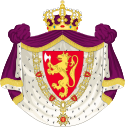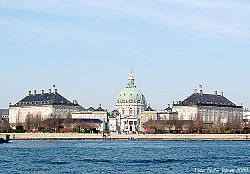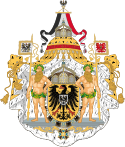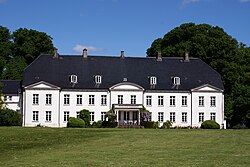Royal Coat of Arms of Greece
- Royal Coat of Arms of Greece under the Glücksburg dynasty, created after the restoration of King George II to the throne in 1935, to the exile of King Constantine II in 1967 and finally until the abolition of the monarchy in 1973.
- The Escutcheon features the white cross on a dark blue field of Greece. The Inescutcheon features the Arms of the Greek line of the House of Schleswig-Holstein-Sonderburg-Glücksburg. The shield is then topped with a golden Royal Crown.
- It features an escutcheon divided by the red and white cross of the Order of the Danneborg, the first quarter features the arms of Denmark (three crowned blue lions and nine hearts in yellow field). The second of Schleswig (two blue lions passant in yellow field). The third divided into four; the chief features the three royal crowns in blue field of Sweden, the second half with a crowned stockfish on red field of Iceland and the last half divided between the ram of the Faroe Islands and a polar bear of Greenland, both on blue fields. The fourth quarter is divided between two halves, the chief depicts a yellow field with a blue lion passant over nine red hearts of the King of the Goths, the lower half depicts a crowned golden lindorm on a red field of the King of the Wends.
- Upon it is another inescutcheon in red, divided into four quarters: the first a a silver nettle leaf of Holstein, the second the a swan with a golden crown of Stormarn, the third a knight dressed in golden armor on a silver horse of Dithmarschen and the fourth of a golden horse's head of Lauenburg.
- Upon it is another inescutcheon divided the first features the red and yellow bars of Oldenburg, the second a golden cross on a blue field of Delmenhorst.
- The escutcheon rests on a golden pedestal and supported by two human figures representing the Greek mythological hero Herakles (Heracles), holding a wooden club and wearing the skin of the Nemean lion.
- The escutcheon is surrounded by the ribbon and cross of the Order of the Redeemer, the cross depicts Christ Pantocrator, surrounded by the order's motto:"Η ΔΕΞΙΑ ΣΟΥ ΧΕΙΡ, ΚΥΡΙΕ, ΔΕΔΟΞΑΣΤΑΙ ΕΝ ΙΣΧΥΙ" or "Thy right hand, O Lord, is become glorious in power" from Exodus, 15:6.
- The motto of the Coat of arms and of the dynasty, depicted on a golden ribbon below the pedestal reads: "Ἰσχύς μου ἡ ἀγάπη τοῦ λαοῦ" or "The people's love, my strength"
- The coat of arms is then surrounded by a dark blue mantle and topped with another royal crown.
In Deutschland kann diese Lizenzvorlage bei Werken, die vor 1995 veröffentlicht wurden, daher nur genutzt werden, wenn nachgewiesen werden kann, dass der Urheber in den 70 Jahren nach Veröffentlichung nicht bekannt wurde oder sich zur Urheberschaft bekannt hat. Dies ist bei verwaisten Werken häufig nicht möglich; in diesem Fall kann dieser Lizenzbaustein nicht genutzt werden.
Wenn dieses Werk anonym oder pseudoanonym ist, benutze diese Vorlage für Medien, die Werke zeigen, welche vor mindestens 70 Jahren veröffentlicht wurden.
Sollte die Erstveröffentlichung im Vereinigten Königreich erfolgt sein, nutze {{PD-UK-unknown}}.Relevante Bilder
Relevante Artikel
Liste der griechischen Orden und EhrenzeichenDiese Liste gibt einen Überblick über die griechischen Orden und Ehrenzeichen. .. weiterlesen
Marie-Chantal von GriechenlandMarie-Chantal Miller ist die englische Ehefrau des griechischen Thronfolgers im Exil Paul von Griechenland. Ihre offizielle Anrede in Dänemark lautet: „Ihre Königliche Hoheit Kronprinzessin Maria-Chantal von Griechenland, Prinzessin von Dänemark“. .. weiterlesen
Wappen GriechenlandsDas offizielle Staatswappen Griechenlands ist seit dem 7. Juni 1975 in Gebrauch. .. weiterlesen
Konstantin II. (Griechenland)Konstantin II. von Griechenland war vom 6. März 1964 bis zur Abschaffung der Monarchie am 1. Juni 1973 der letzte König der Hellenen. .. weiterlesen
Schleswig-Holstein-Sonderburg-GlücksburgSchleswig-Holstein-Sonderburg-Glücksburg, kurz Haus Glücksburg, ist der Name einer 1825 gegründeten Linie, die dem Haus Schleswig-Holstein-Sonderburg entstammt, einer Nebenlinie des Gesamthauses Oldenburg. Nach dem Erlöschen der Linie Schleswig-Holstein-Sonderburg-Augustenburg im Jahr 1931 ist die Glücksburger Linie, deren Name auf das Glücksburger Schloss an der Ostsee verweist, die einzige noch bestehende deutsche Linie des Hauses Schleswig-Holstein. .. weiterlesen
Paul von Griechenland (1967)Paul (Pavlos) von Griechenland aus dem Haus Schleswig-Holstein-Sonderburg-Glücksburg war bis zur Abschaffung der griechischen Monarchie durch die Militärjunta unter Georgios Papadopoulos 1973 Kronprinz von Griechenland. In Dänemark ist seine offizielle Anrede aufgrund seiner dänischen Vorfahren heute noch „Seine Königliche Hoheit Kronprinz Pavlos von Griechenland, Prinz von Dänemark“. .. weiterlesen
Irene von GriechenlandIrene von Griechenland ist eine ehemalige Prinzessin von Griechenland. .. weiterlesen










































